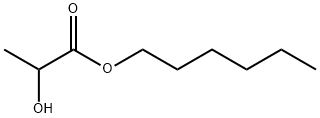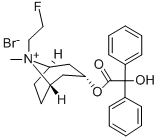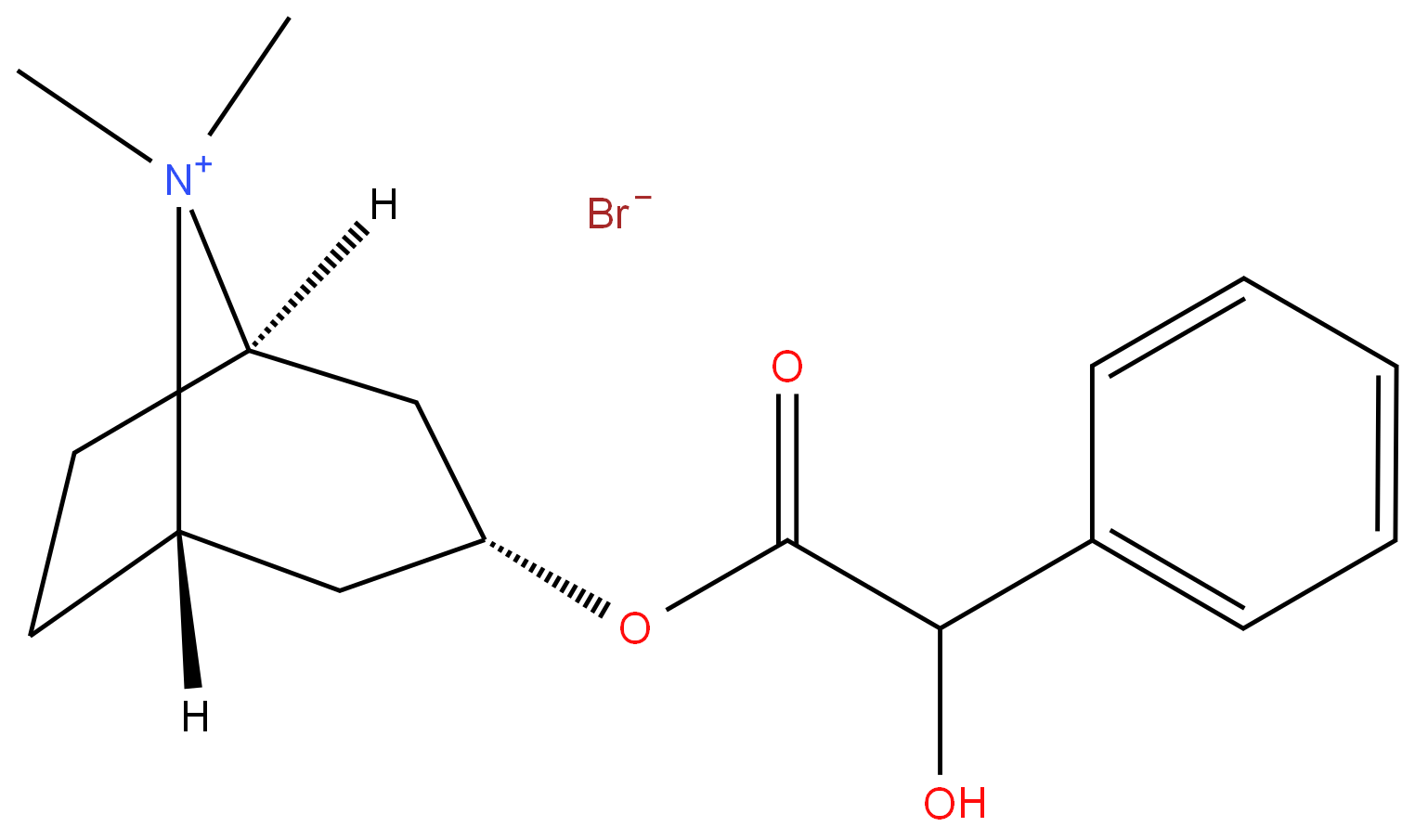HOMATROPINE METHYL BROMIDE
Synonym(s):Homatropine methobromide;Homatropine methylbromide
- CAS NO.:80-49-9
- Empirical Formula: C17H24BrNO3
- Molecular Weight: 370.28
- MDL number: MFCD00050292
- EINECS: 201-284-0
- SAFETY DATA SHEET (SDS)
- Update Date: 2025-12-11 08:41:34

What is HOMATROPINE METHYL BROMIDE?
Chemical properties
White or almost white, crystalline powder or colourless crystals
The Uses of HOMATROPINE METHYL BROMIDE
Homatropine methylbromide or Methylhomatropine bromide is a quaternary ammonium salt of methylhomatropine. Methylhomatropine is a peripherally acting anticholinergic medication that inhibits muscarinic acetylcholine receptors and thus the parasympathetic nervous system. Methylhomatropine does not cross the blood–brain barrier. Methylhomatropine is used, in addition to papaverine, as component of mild drugs that help "flush" the bile.
The Uses of HOMATROPINE METHYL BROMIDE
anticholinergic (opthalmic)
Background
Homatropine methylbromide is a quaternary ammonium muscarinic acetylcholine receptor antagonist belonging to the group of medicines called anti-muscarinics. Homatropine is used to treat duodenal or stomach ulcers or intestine problems. It can be used together with antacids or other medicine in the treatment of peptic ulcer. It may also be used to prevent nausea, vomiting, and motion sickness.
Indications
Used in conjunction with antacids or histamine H2-receptor antagonists in the treatment of peptic ulcers, gastric ulcers and duodenal ulcers, to reduce further gastric acid secretion and delay gastric emptying.
brand name
Equipin (Mission); Homapin (Mission).
General Description
Homatropinemethylbromide, 3 -hydroxy-8-methyl-1 H,5 H-tropaniumbromide mandelate (Novatropine, Mesopin), occurs as a bitter,white, odorless powder and is affected by light. The compoundis readily soluble in water and alcohol but insoluble inether. The pH of a 1% solution is 5.9 and that of a 10% solutionis 4.5. Although a solution of the compound yields a precipitatewith alkaloidal reagents, such as mercuric potassiumiodide test solution, addition of alkali hydroxides or carbonatesdoes not cause the precipitate that occurs with nonquaternarynitrogen salts (e.g., atropine, homatropine).
Pharmacokinetics
Homatropine methylbromide belongs to the group of medicines called anti-muscarinics. Homatropine is used to treat duodenal or stomach ulcers or intestine problems. It can be used together with antacids or other medicine in the treatment of peptic ulcer. It may also be used to prevent nausea, vomiting, and motion sickness.
Clinical Use
Homatropine methylbromide is transported poorly acrossthe blood-brain barrier because of its quaternary ammoniumgroup and, therefore, has far fewer stimulant properties thanatropine. It does have all the characteristic peripheralparasympathetic depressant properties of atropine and isused to reduce oversecretion and to relieve GI spasms.
Metabolism
Not Available
Properties of HOMATROPINE METHYL BROMIDE
| Melting point: | 192°C |
| storage temp. | -20°C Freezer |
| solubility | Freely soluble in water, soluble in ethanol 96 per cent |
| form | neat |
| form | Solid |
| color | White to Off-White |
| Merck | 14,4730 |
| CAS DataBase Reference | 80-49-9(CAS DataBase Reference) |
| EPA Substance Registry System | Homatropine methylbromide (80-49-9) |
Safety information for HOMATROPINE METHYL BROMIDE
| Signal word | Warning |
| Pictogram(s) |
 Exclamation Mark Irritant GHS07 |
| GHS Hazard Statements |
H302:Acute toxicity,oral |
Computed Descriptors for HOMATROPINE METHYL BROMIDE
New Products
4,4-Difluoropiperidine hydrochloride tert-butyl 9-methoxy-3-azaspiro[5.5]undecane-3-carboxylate Indole Methyl Resin N-Isopropylurea N,N-Dicyclohexylcarbodiimide(DCC) MELDRUMS ACID 5-METHYLISOXAZOLE-4-CARBOXYLIC ACID Magnessium Bis glycinate Zinc ascorbate 1-bromo-2-butyne 2-acetamidophenol 9(10H)-anthracenone Erythrosin B, 4-Piperidinopiperidine 2-((4-morpholinophenylamino) (methylthio) methylene) malononitrile 2,4-dihydroxybenzaldehyde 3-(4-morpholinophenylamino)-5-amino-1H-pyrazole-4-carbonitrile Methyl 2-methylquinoline-6-carboxylate 2,6-dichloro-4-nitropyridine 4-Bromo-2-chlorobenzonitrile 2-(benzylamino)acetic acid hydrochloride 4-(tert-Butoxycarbonylamino)but- 2-ynoic acid 3,4-dihydro-2H-benzo[b][1,4]dioxepine 1-Phenyl-1-cycloprppanecarboxylicacidRelated products of tetrahydrofuran



![8-METHYL-8-AZABICYCLO[3.2.1]OCTANE](https://img.chemicalbook.in/CAS/GIF/529-17-9.gif)




You may like
-
 80-49-9 Homatropine Methylbromide 98%View Details
80-49-9 Homatropine Methylbromide 98%View Details
80-49-9 -
 Homotropine Methyl Bromide 99%View Details
Homotropine Methyl Bromide 99%View Details -
 80-49-9 Homatropine Methylbromide 99%View Details
80-49-9 Homatropine Methylbromide 99%View Details
80-49-9 -
 80-49-9 Homatropine Methylbromide 98%View Details
80-49-9 Homatropine Methylbromide 98%View Details
80-49-9 -
 Homatropine Methyl Bromide CAS 80-49-9View Details
Homatropine Methyl Bromide CAS 80-49-9View Details
80-49-9 -
 Homatropine methylbromide 98.00% CAS 80-49-9View Details
Homatropine methylbromide 98.00% CAS 80-49-9View Details
80-49-9 -
 Homatropine methylbromide >98% (HPLC) CAS 80-49-9View Details
Homatropine methylbromide >98% (HPLC) CAS 80-49-9View Details
80-49-9 -
 Homatropine methylbromide CAS 80-49-9View Details
Homatropine methylbromide CAS 80-49-9View Details
80-49-9
